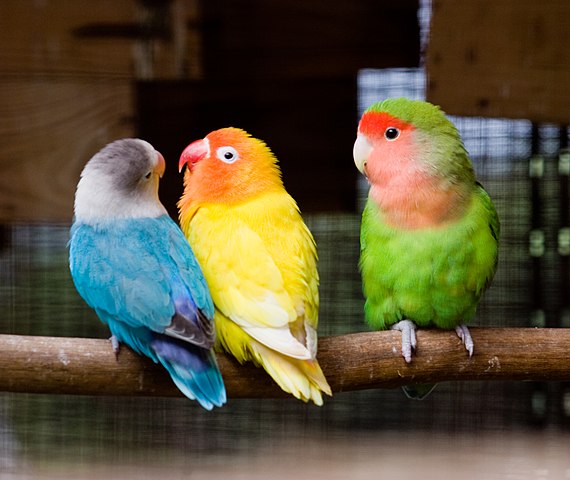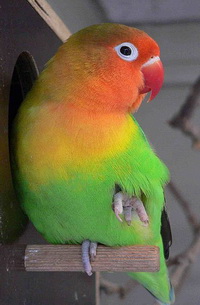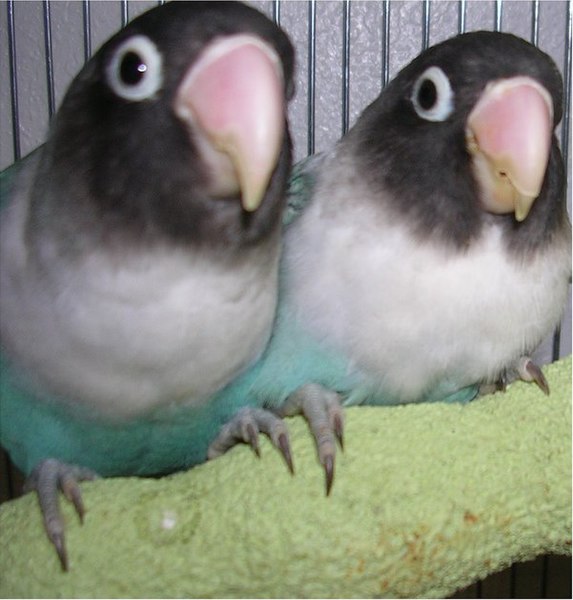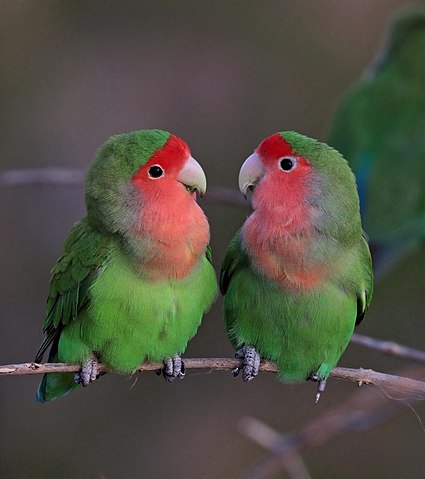Lovebirds are some of the smallest parrots ranging in size from 4 to 7 inches. They are comparable in size to Budgerigars or Parakeets. They make excellent pets because of their size and because they allow people in apartments to enjoy the beauty of a parrot without the noise and space requirements. Lovebirds live up to 15-18 typically years with proper care.

If you’re considering adding a Lovebird to your family, you might want to ask yourself these questions:
1) Do I have a safe and appropriate space available for this bird?
2) Do I understand that owning this bird will be a life-long commitment?
3) Am I willing and able to spend supervised time with this bird outside of the cage?
4) Will the natural calls and sounds of this bird be bothersome to me or anyone in my family?
5) Will I, or another mature responsible person, take on the responsibility of caring for this bird?
If you can answer yes to each of these, congratulations! A Lovebird may be the perfect choice for your new family pet. If you want to raise a lovebird that’s thrilled to spend time with you we can show you how!

Lovebirds originated in Africa and Madagascar and are now some of the most popular of all parrots. They are energetic, and curious, and come in a wide variety of colors. They love to chew on things, so providing safe chew toys is a must. They also love to take baths, so you’ll want to include a shallow bowl for them to bathe in.
Lovebirds can also be territorial, and that may include choosing one family member over the others. They chatter quite loudly but are nowhere near as noisy as their larger cousins.
Although Lovebirds chatter quite a bit, and they can learn to mimic the human voice, most do not learn to talk. Just because they don’t talk back doesn’t mean that you shouldn’t talk with them when you give them the care and attention that it craves.
You may actually be surprised to hear a word or phrase slip from their little beak. The more time and attention are given to your Lovebird, the less likely your bird will develop behavior problems like biting or feather picking.
There are nine species of lovebirds; eight of the nine can be purchased as pets. The eight species available as pets are
- Abyssinian Lovebirds
- Red-faced Lovebirds
- Nyasa Lovebirds (Lilian’s)
- Black-cheeked or Black-faced
- Blue Fischer Lovebirds
- Masked Lovebirds (Black-masked or
- Madagascar Lovebirds Yellow-collared Grey-headed
- Peach-faced or Rosy-faced

The Black-collared Lovebird is generally not available as a pet because it does not do well in captivity.
It is often recommended that instead of buying one lovebird, you buy two because they are such social birds. You know best the time you have to devote to a bird or birds.
Don’t expect to purchase a huge 3×4 foot cage for your Lovebird. They need an appropriately sized cage that is large enough that they have move around freely while still having the security they need when they’re home alone. It is often recommended that instead of buying one lovebird, you buy two because they are such social birds. You know best the time you have to devote to a bird or birds.
Lovebirds enjoy variety, much like their human family. A commercially prepared pellet, specially formulated for their nutritional needs, can be supplemented with fruits, seeds, and vegetables. Fresh greens, such as spinach or kale, are very beneficial. Some owners even share their own meals with their lovebirds. Of course, you will have to decide if you’re comfortable doing this, but lovebirds can eat quite a few human foods.
Lovebirds are the easiest of the parrot family to keep. They aren’t extremely destructive and they aren’t particularly loud even though they chatter all day. They may try to “discipline” you with their beak, but you can’t allow them to do so. Teach them through proper training and patience that biting is not acceptable. Before long, your dominance will be established and the biting will be a thing of the past.
These little colorful birds truly can be great companions. They can easily live to be 15-18 years old, so it’s important to establish and maintain an affectionate relationship with your Lovebird. After all, this relationship may last as long as some of your human relationships.

Lovebird Price
Lovebirds are generally cheap to buy and not expensive to maintain. They make excellent companions and you don’t need to break the bank to have these wonderful parrots around you.
You can find lovebirds as cheap as $50 in some pet shops but generally expect to pay for a healthy one $100. Some rarer species such as the Blue Fischer lovebird may go for as much as $400-$500 and some even rarer breeds may sell for $1,200.
As always, it is best to buy from a respected breeder rather than a pet shop if at all possible. Lovebirds do not need expensive food or expensive cages so expect to pay less than $40 monthly on average to feed and care for them unless you need to see the veterinarian.
In general, however, Lovebirds are easy to maintain as long as you are attentive to their needs. Remember, too, Lovebirds are simply small parrots and as such, they have the same intelligence and abilities as larger parrots. They have also been known to mimic sounds and words. Thus, just because they are generally cheaper to buy and cheaper to maintain than larger parrots, it does not mean they need less attention or appreciation.
Feeding
In the wild Lovebirds are free to select from a wide range of seeds, greens, insects, and other foods. It is possible to buy standard commercially prepared foods reasonably at any pet shop. However, seeds should be supplemented with fruit and green foods, tree branches, and occasional soft foods. Offer a combination of fresh vegetables and/or fruits each day.
You could offer some sprouted seeds. Soak some of the seed mixes in clean water for 24 hours and place them in a warm place for a couple of days. When the seeds sprout rinse them in water and offer them to the Lovebird. Vegetables, which can be offered, include Brussels sprouts, cabbage, spinach, parsley, also dandelion, chickweed, and shepherd’s purse. Some common fruits include figs, soaked raisins, apples, sweet oranges, soft pears, and peaches.
